THE GEORGE GRIGGS MUSIC COLLECTION * The 4 Seasons * Vee Jay Records (1962)
Reflecting Today. In His Memory. This single was George Grigg’s all-time favorite song, by group. The 4 Seasons. — Greg Innis
![]()
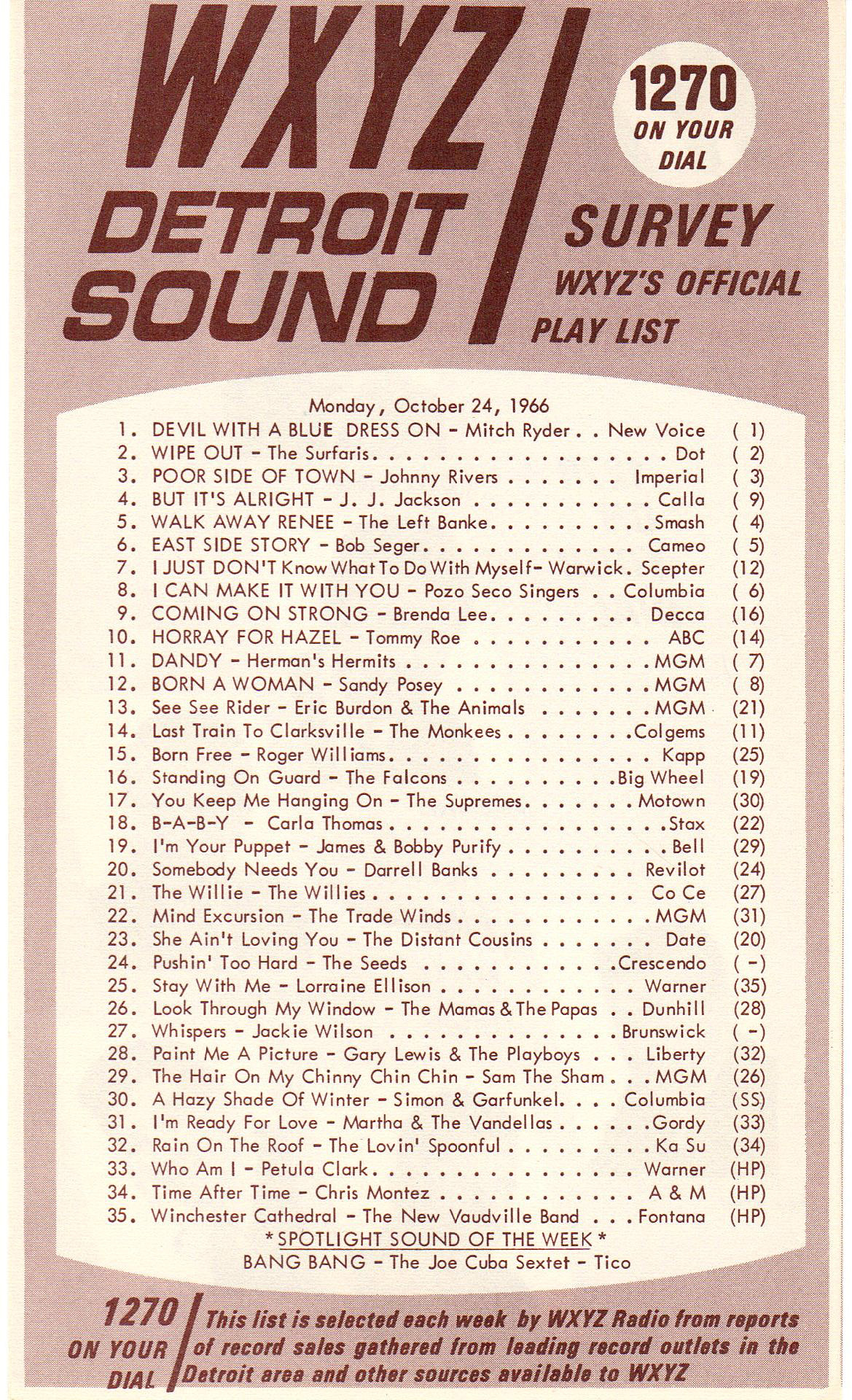





















A MCRFB VIEWING TIP: To fully appreciate this WXYZ RADIO 1270 October 24, 1966 chart feature click on image 2x and open to second window. Click image anytime to return to NORMAL image size.
Click your server’s back button to return to MCRFB home page.
On your mobile device? Tap on chart image. Open to second window. “Stretch” chart across your device screen to magnify for largest print view.
All 21 featured song titles randomly were selected for your listening enjoyment, here.


![]()
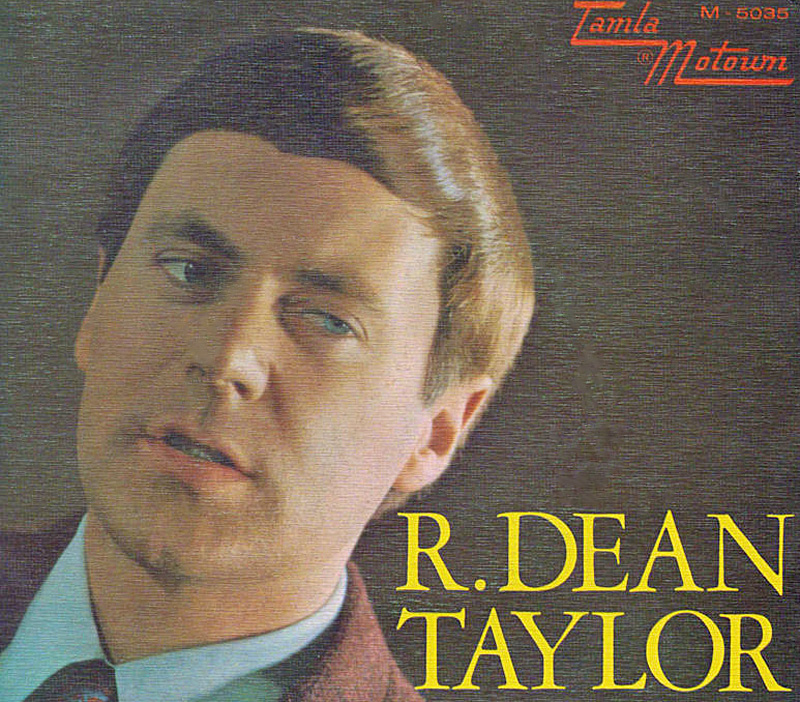
![]()
Today, Motor City Radio Flashbacks’ presents our 50th Motown instrumentals install, recalling, honoring the sound of Detroit’s legendary Funk Brothers. You will find every single one of our Funk Brothers audio sessions featured and cataloged on this website to date thus far, by GOING HERE. More to come!
![]()
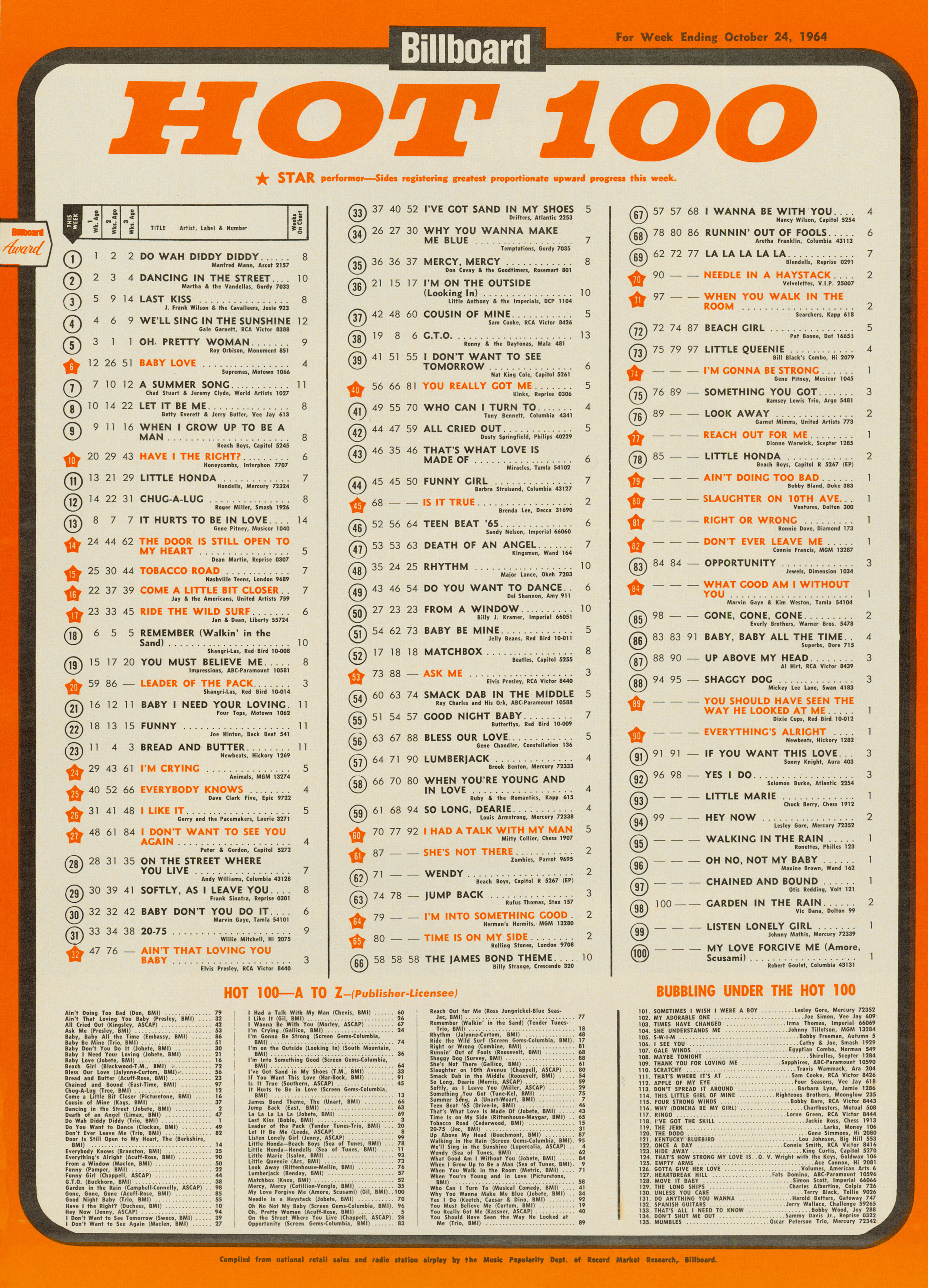

























A MCRFB VIEWING TIP: ON YOUR PC? To fully appreciate this Billboard Hot 100 October 24, 1964 chart feature click on image 2x and open to second window. Click image anytime to return to NORMAL image size.
Click your server’s back button to return to MCRFB home page.
On your mobile device? Tap on chart image. Open to second window. “Stretch” chart across your device screen to magnify for largest print view.
These were the records you bought. Many went on to become some of the most popular singles heard played on AM Top 40 radio, October of 1964, on WKNR, CKLW, WXYZ and conservative album-oriented, easy-listening WJR and (conservative new-comer) WJBK in Detroit.



![]()
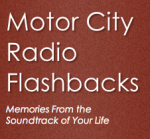 From the MCRFB radio news scrapbook: 1945
From the MCRFB radio news scrapbook: 1945
LOCAL PROGRAMMING HEDGES POSTWAR
Stations Go, Live in Hopes
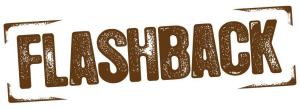 DETROIT (May 26, 1945) — Check of all major local stations indicates that emphasis on local programming is continuation of fairly long-time trend. In general, it has been something the stations has been doing for the last three years.Typically, WWJ has increased programming cost heavily in last two years, and WWJ has had a 73-piece symphony orchestra sponsored by a cut-rate department store for the two and a half years in a full hour Saturday night show with barely any mention of the sponsor.
DETROIT (May 26, 1945) — Check of all major local stations indicates that emphasis on local programming is continuation of fairly long-time trend. In general, it has been something the stations has been doing for the last three years.Typically, WWJ has increased programming cost heavily in last two years, and WWJ has had a 73-piece symphony orchestra sponsored by a cut-rate department store for the two and a half years in a full hour Saturday night show with barely any mention of the sponsor.
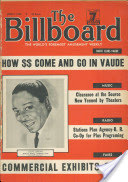
Trend is definitely continuing, with new developments, both commercial and sustaining, tending away from the all-platter shows, except in post-midnight and early-a.m. hours, where they appear to have a permanent useful place. WWJ for the last year has done a job with Nurses In Action, dramatizing the nurse recruiting campaign, and Victory Matinee, devoted each Wednesday afternoon to a different war effort cause and using the full talent resources of the station. Another show of typical operations here is Tenth Floor, Please, sponsored by a department store, which dramatizes the story of products sold on this floor.
In the last year, WJR pioneered in inter-station contacts for ideas, sending out five teams of station men, paired from different departments — typically the commercial manager and the program director — on one-week junkets around the country to inspect station operations in other cities.
Recently a swing quartet from the Motor Bar was put on the air for 15 minutes at 9:45 — at a cost of $65.00 daily — chiefly to break into the general soap opera schedule with something that wasn’t transcriptions, until change of schedule forced its abandonment.
Check on inter-station cooperation indicate this is largely by letter elsewhere. WXYZ, typically, reports frequent interchange of ideas, and requests for info on how the station has solved particular problems — such as what they do on department store programs. Most of these correspondence come from stations of the affiliated Blue. Station has made a practice of working closely on production with clients and agencies, in contrast to WJR, where the station typically done its own particular show packaging and then offered the product for sale.
Recorded programs on WXYZ have been reduced some 50 per cent in the past year — chiefly in favor taking net shows, rather than local production, in which the station was already strong, originating at least three week serials — notably Lone Ranger. Another trend toward better programming here is the move away from short records in favor of the larger disks with a full 15-minutes of music, or re-broadcasts.
The move toward better programming emphasis appears concentrated in smaller towns, typified by Michigan Radio Network, which has heavily moved this way within the past three months. END
(Information and news source: Billboard; June 2, 1945).
![]()
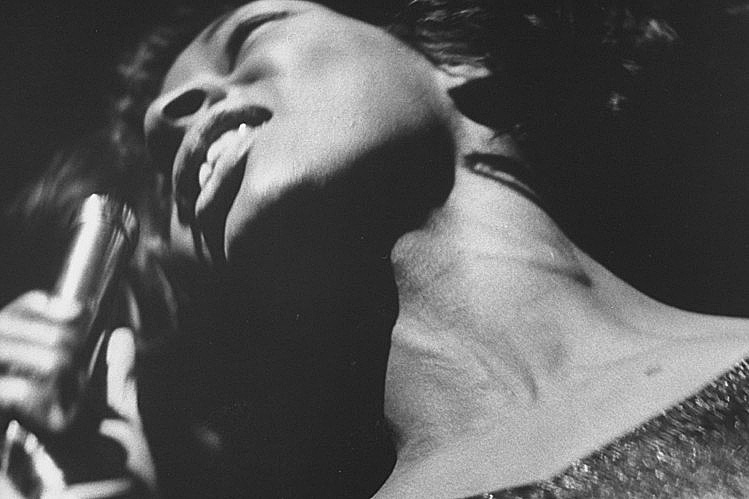
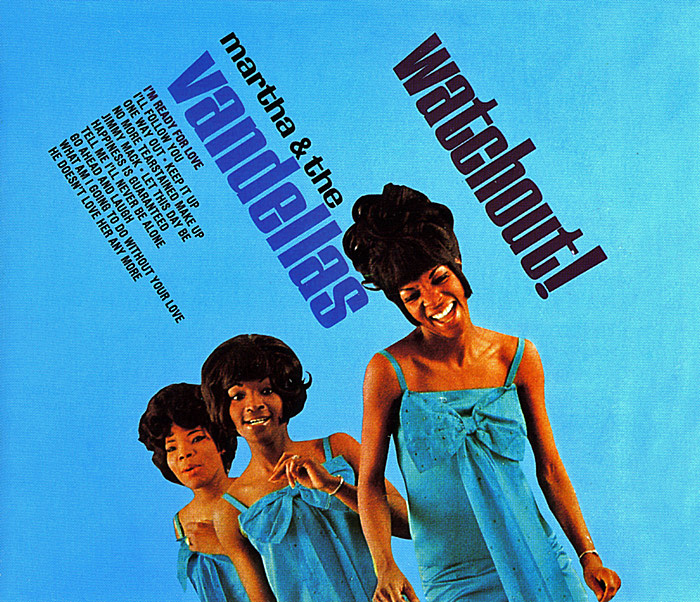
![]()
 From the MCRFB NEWS archive: 1963
From the MCRFB NEWS archive: 1963
One Million Stereo FM Receivers Will Be Sold, 1963
NEW YORK — FM STEREO’S HOTTEST MARKETS. One million stereo receivers will be sold this year. Not bad for for a medium which celebrated it’s second birthday this month.
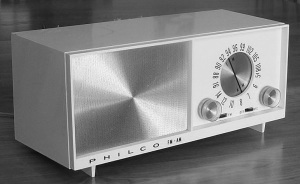
About 730,000 of the anticipated 1.4 million American-made radio-phonographs will be equipped for FM stereo reception; another 130,000 of 280,000 TV-radio-phonograph combinations will have it. Add at least another 100,000 for table-model FM stereo radios and FM-stereo equipped imports of various types, plus another 50,000 or so component tuners, and you have well over a million sets going to the public this year. (The radio-phono and TV-radio-phono estimates were made by the Electronics Industries Association; other estimates tabulated by Billboard).
FM stereo is a valuable adjunct to a phonograph. It vastly increases the consumer’s enjoyment — and the dealer’s profits. It can be sold easily with a good demonstration. The same is true of FM stereo table radio.
THERE ARE NOW 228 FM stereo stations in the U.S., and about 10 in Canada. FM stereo can truly be called a nationwide medium today. The American stations are located in 209 cities in 44 States plus the District of Columbia and Puerto Rico. FM stereo signals can be received in every one of the top 50 U. S. metropolitan market areas — and in many, many less populated areas.
FM stereo is far hotter in some areas than others, of course. In these “hot” areas, every radio-phono sold should contain FM stereo. FM listeners are subject to a constant barrage of FM-stereo talk on their favorite stations, and this talk can be converted to sales with a little effort.
These are FM stereo’s hottest cities (not necessarily in order): Los Angeles, San Francisco, Chicago, Detroit, Philadelphia, Houston, Seattle. Each one of these cities has at least 5 FM stations broadcasting in stereo. Detroit has six. Los Angeles and Seattle will soon add their sixth. San Francisco, long reputed to be the hottest FM-stereo town of all, probably deserves this reputation. With five stations already broadcasting in stereo, three more have purchased stereocasting equipment and presumably will soon begin stereo, to make San Francisco the nation’s first eight-stereo-station city.
The second-hottest group of stereo cities (in order of number of stereocasting stations) consists of San Diego, Miami (with a fifth station due to begin soon), Boston, Dallas-Ft. Worth also expecting No. 5 on the air soon). Each of these cities currently has four FM stereo program sources.
Three-stereo-stations areas are Washington; Minneapolis-St. Paul; Cleveland; Eugene-Springfield, Oregon; Madison and Milwaukee, Wisconsin.
There are at least 18 cities where listeners have a choice of two FM stereo stations. Geographically, they’re scattered from border-to-border and coast-to-coast. They are Phoenix, Birmingham, Fresno and Sacramento, California; Atlanta; Honolulu; Cedar Rapids, Iowa; Grand Rapids, Michigan; New York; St. Louis; Greensboro, North Carolina; Oklahoma City and Tulsa, Oklahoma; Portland, Oregon; Pittsburg, Providence, Norfolk, Nashville.
There’s no particular pattern of geographic location or city size in the spread of FM stereo. In many cases, a good, well-operated FM stereo station (such as San Francisco’s KPEN) will build an audience and inspire its competitors to “go stereo.”
NEW YORK, YOU WILL NOTE, is rather far down on the list. The city has never been a trail-blazing town in home entertainment. New York’s FM stereo boom may come soon, however, as at least three more stations are preparing to start stereocasting. For serious music lovers, who are now served with some stereo by WQXR-FM, there will be New York’s municipal station WNYC-FM, which hopes to eventually stereocast all of its live concert broadcasts, and ABC’s WABC-FM, which will program separately from its AM affiliate, presumably serious music. For those who prefer lighter music, the popular WPAT-FM will supplement WTFM. now programming stereo 24 hours daily.
NEXT STEREO CITIES. Between 50 and 75 more FM stations will begin stereocasting between now and the end of 1963. These are expected to open up more new markets for stereo equipment sales.
Among the upcoming new FM stereo market areas where stations are now equipping themselves to start stereo broadcasting: Mobile, Alabama; Tucson, Arizona; Boulder, Colorado; Columbus, Georgia; Boise, Idaho; Champaign, Illinois; Louisville; St. Joseph, Missouri; Los Alamos, New Mexico; Dover, Springfield, and Toledo, Ohio; Warren and York, Pennsylvania; Seneca, South Carolina; Greenville, Johnson City and Lebanon, Tennessee; Lubbock and Midland, Texas; Bellingham, Washington; Eau Claire, Green Bay and Wausau, Wisconsin; Cheyenne, Wyoming; Aguadilla and Isabele, Puerto Rico.
If your business is located in or near any of these cities, its not too early to prepare for the advent of FM stereo. Your customers should be told that FM stereo is coming, and advised to be ready for it. You should be ready for it, too., with an adequate supply of FM-stereo-equipped instruments., and armed with knowledge of what it’s all about. END
___
(Information and news source: Billboard; June 29, 1963)
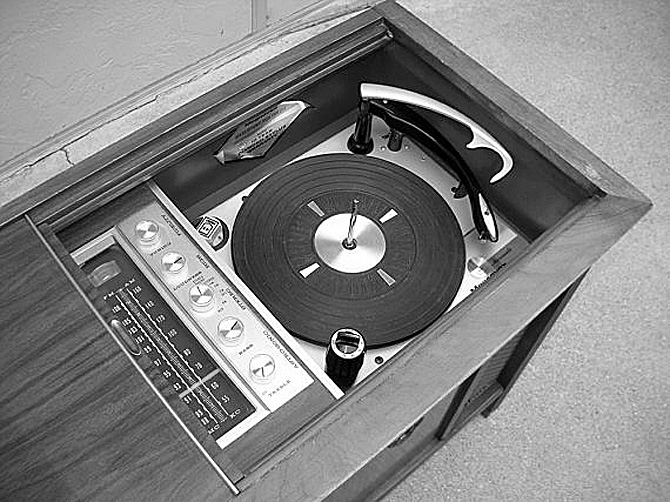

![]()
 From the MCRFB news archives: 1969
From the MCRFB news archives: 1969
DETROIT — Motown Records is moving into its own cassette tape operation, including packaging, merchandising, and distribution, beginning Monday, September 1.
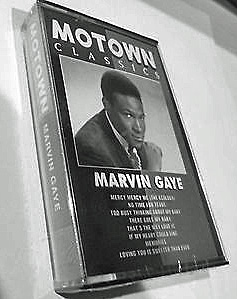
RCA will duplicate Motown’s new cassette product, with Ampex, the previous cassette licensee, duplicating only reel-to-reel. Muntz Stereo-Pak will continue to duplicate Motown’s 4-track.
Motown’s initial cassette release under its own banner will be culled from catalog material. A fall production will emphasize new product.
The company will sell cassettes a $6.95, the same price as it’s 8-tracks, which it also markets and distributes.
Mel DaKroob, Motown national tape and album sales manager, said the increased emphasis on tape product is paying off. He feels 8-track sales this year will hit 3 million units. At the end of the first six-months of 1969, Motown’s 8-track sales increased 120 per cent over the same period in 1968. END
(Information and news source: Billboard; September 6, 1969).
![]()